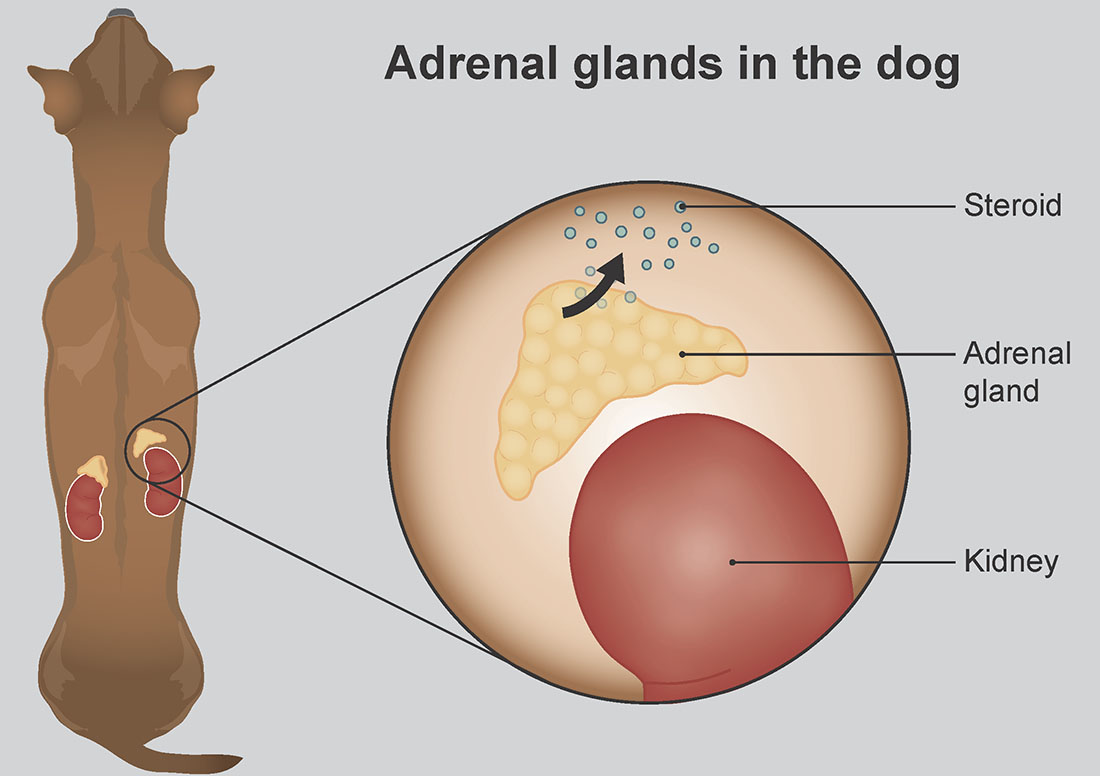Cushing’s Disease in dogs
Overview
- Cushing’s disease is a condition caused by abnormally high levels of the hormone cortisol in the body, which is normally produced in exact amounts by the adrenal glands.
- It causes a wide range of symptoms, including excessive drinking and weeing, bald patches, excessive appetite, and a pot-belly.
- Treatment for Cushing’s involves daily lifelong medication to reduce cortisol production.
- With treatment, the outlook for a dog with Cushing’s is good.
- Although Cushing’s can affect any dog, it’s more common in middle-aged, small breeds such as Terriers, Poodles and Dachshunds.
What is Cushing’s Disease?
Cushing’s disease (also known as hyperadrenocorticism) is a condition that develops in the body due to high levels of the hormone cortisol. Cortisol is an essential hormone normally produced by the adrenal glands and the amount produced is closely controlled by signals from the pituitary gland in the brain. Cushing’s disease develops when the adrenal gland becomes overactive and releases too much cortisol. This can be due to:
- A tiny brain tumour in the pituitary gland– that sends too many signals to the adrenal glands, telling them to produce more cortisol. This is the most common cause of Cushing’s. A brain tumour sounds scary but it’s usually a small, benign tumour that causes no problems other than Cushing’s. Some breeds are prone to this type of Cushing’s such as Poodles, Dachshunds, and Yorkshire Terriers. It will usually be seen in middle to older age dogs.
- An adrenal gland tumour– that causes the adrenal gland to become overactive and produce more cortisol than normal.
A similar condition, called Cushing’s syndrome can be caused by:
- High dose steroid medication- occasionally, Cushing’s is brought on by long-term, high dose steroid medication. This is called iatrogenic Cushing’s. If you are concerned that your dog is showing any symptoms of Cushing’s, you should never change the dose of medication your dog is on without discussing it with your vet first

The adrenal glands usually produce steroid. Click image to enlarge.

Symptoms of Cushing's include a pot belly. Click image to enlarge.
Symptoms
Common symptoms of Cushing’s include:
- Excessive drinking and peeing
- A ‘pot-belly’ (swollen stomach)
- Bald patches, especially on the sides/flanks and tail
- Excessive hunger
- Dark patches on skin
- Thin, scaly skin prone to blackheads and infections
- Wounds that are slow to heal
- Low energy (lethargy)
- Panting more than usual
- Muscle loss/wastage
When to contact your vet
Contact your vet if you think your dog has symptoms of Cushing’s, even if they seem otherwise well. It will help your vet if you take a urine sample and a note of how much your dog drinks in a 24-hour period. Watch our videos below for guidance on how to collect a urine sample and measure how much your dog is drinking.
You know your dog best, always contact your vet if you’re concerned
Diagnosis
Dogs with Cushing’s disease often develop a unique appearance, so your vet may suspect the condition simply by looking at your dog. However, further tests are needed as there are other illnesses that can show similar signs and it is important to confirm the diagnosis before starting your dog on lifelong medications.
Tests may include blood tests (they will usually need more than one blood test), urine tests and an ultrasound scan. Advanced imaging such as a CT (computerised tomography) may also be advised by your vet. Sometimes, it can be tricky to diagnose Cushing’s and your vet may suggest repeating some tests over a period of time before getting a diagnosis.
Treatment
Medication – most cases of Cushing’s can be treated with medication that controls cortisol production. The medication needs to be given to your dog for the rest of their life. It’s important to give the correct dose because if too much is given, cortisol levels may drop dangerously low and cause Addison’s disease (hypoadrenocorticism). Contact your vet immediately if you suspect your dog has had an overdose of their medication.
Surgery – specialist vets may operate to remove the tumour in the adrenal gland or brain but it’s important to be aware that these surgeries have risks and are expensive. Talk to your vet about whether these surgeries may be suitable for your dog.
For iatrogenic Cushing’s – depending on why your dog is on steroids, it may be possible to wean the steroid dose down gradually with the aim of eventually stopping steroid treatment. This is always done gradually, as stopping steroids suddenly can cause serious health issues for your dog. Always speak to your vet before changing any dose of medication.
Ongoing care
Regular vet checks will be necessary to monitor your dog’s progress, particularly in the first few months after diagnosis. Blood tests are often necessary to check your dog’s cortisol levels to ensure they are on the right amount of medication.
Monitoring at home. Monitor your dog and keep a note of any new or changing symptoms.
Drinking and peeing. Never restrict your dog’s access to water and make sure they always have somewhere to pee. It can take a few weeks for symptoms to improve and they may always drink and pee a little more than they used to. It’ll help your vet if you keep a water diary i.e. every 1-2 weeks, make a note of how much your dog drinks in a 24-hour period.
Outlook
With treatment. If your dog responds well to treatment, some symptoms are likely to start improving within a few weeks (other symptoms take a few months to improve) and their outlook is very good. Many dogs with well-controlled Cushing’s can live a relatively normal and happy life for many years.
Without treatment. Some dogs with Cushing’s disease live without treatment for some time, but tend to be happier and healthier with a better quality of life on medication. Left untreated, they are more prone to contracting infections, they will become more lethargic over time and all of their symptoms will gradually worsen.
Cost
Treatment for Cushing’s disease can become very expensive, especially because it’s an ongoing condition that needs lifelong medication and monitoring. It’s important to speak openly with your vet about the cost of treatment, your finances, and what you think is right for your dog.
Consider taking out dog insurance as soon as you bring your dog home, before any signs of illness start. This will give you peace of mind that you have some financial support if they ever become unwell.
- Will long-term steroid medication give my dog Cushing’s?
- How long does a dog live with Cushing’s disease?
- What would happen if I decided not to treat my dog for Cushing’s disease?
- Is there any way of preventing Cushing’s disease?
- What is the difference between Cushing’s disease and Cushing’s syndrome?
Will long-term steroid medication give my dog Cushing’s?
High doses of steroids over a long period can cause Cushing’s. Some dogs with chronic conditions such as allergic skin disease, immune mediated disease and Addison’s need long-term steroid medication. Your vet will be aware of the risks of giving long-term steroids and will always try to give the lowest effective dose to minimise these risks.
How long does a dog live with Cushing’s disease?
Most dogs with Cushing’s disease respond well to medication and can go on to lead a good quality life for a long time if they have no other health issues.
What would happen if I decided not to treat my dog for Cushing’s disease?
Some dogs with Cushing’s disease can live for some time without treatment but their quality of life may not be as good as a result of the symptoms of Cushing’s disease. They will be more prone to contracting infections and they will become increasingly lethargic.
Is there any way of preventing Cushing’s disease?
There isn’t anything you can do to stop your dog developing Cushing’s disease.
What is the difference between Cushing’s disease and Cushing’s syndrome?
Cushing’s syndrome is caused by too much cortisol from outside or inside the body. For example, it can be from using high dose long-term steroid medications or it can come from a pituitary or adrenal tumour causing the body to make too much cortisol. Cushing’s disease is a specific type of Cushing’s syndrome caused by a tiny brain tumour in the pituitary gland.
Published: January 2024
Did you find this page useful?
Tell us more
Please note, our vets and nurses are unable to respond to questions via this form. If you are concerned about your pet’s health, please contact your vet directly.
Thank you for your feedback
Want to hear more about PDSA and get pet care tips from our vet experts?
Sign up to our e-newsletter
Written by vets and vet nurses. This advice is for UK pets only. Illustrations by Samantha Elmhurst.

 Video found at youtu.be/U3WIXBEXB8o
Video found at youtu.be/U3WIXBEXB8o
 Video found at youtu.be/xTLRKmNvPzo
Video found at youtu.be/xTLRKmNvPzo
